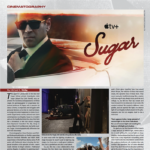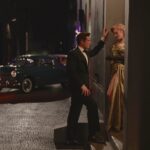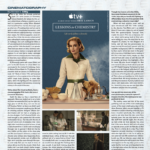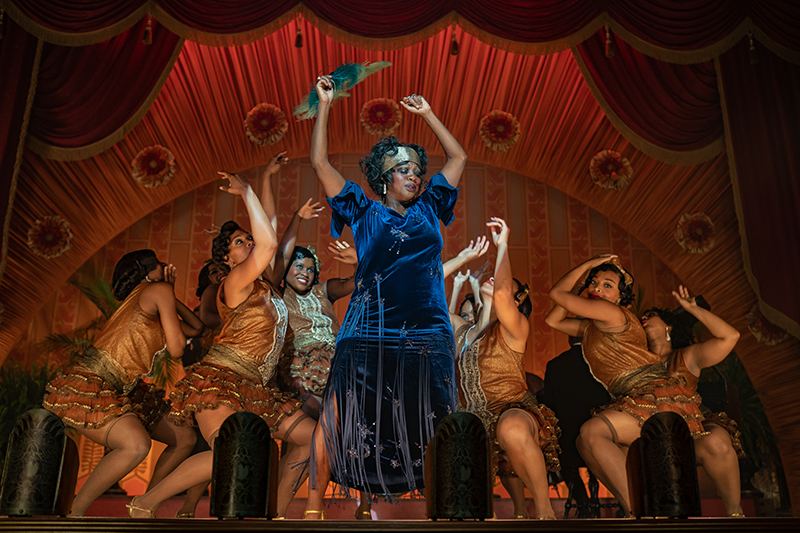
A Talk with Cinematographer Tobias Schliessler
Suspension of disbelief. It is the essence of any film. It is a primary goal of the director and the underlying hope of the viewer. Transportation into another reality is made possible by the cinematographer, and living in that moment is achieved by the actors.
The opening scene of the Netflix hit film Ma Rainey’s Black Bottom follows two young black men running through a moonlit forest, hurriedly dodging their way over the fauna and detritus through streaks of light, then bursting onto a large canvas tent where a crowd gathers for a concert. The cascading luminance coming from that artificial “moon” was achieved by cinematographer Tobias Schliessler.
Within the tent, Schliessler has lit the performers as authentically as possible in an effort to faithfully render the 1927 era in which the film takes place. “I spoke with Jules Fisher and Peggy Eisenhauer,” whom he had collaborated with for Dreamgirls, “to learn how they had done it back then.”
Practical bulbs and only foot lights served the stage, which he augmented with a dome light to create a soft spotted front light on Ma Rainey for her to stand out from the band. “I did cheat a bit with one tungsten balloon to get more ambient light and used Arri Sky Panels for back light,” he says. Close-ups were aided by LiteMat Plus 4’s and Jem Balls.
In cutting from the tent to the theater proper in Chicago midway through the song, Schliessler continued his goals for authenticity. “There are very few Carbon Arc Spotlights left in the U.S., and shipping them to Pittsburgh proved impossible,” he says. Schliessler eventually settled on a 575-watt HMI spotlight, and he used Arri Sky Panels with diffused Chimeras to provide fill and to simulate the spill from the followspot.
Schliessler’s CV is eclectic by design — he believes it is his job to fulfill the director’s vision, to enhance the story and as such, to visually realize any subject or genre. “I feel my strength is being able to put a director’s vision on a screen. I don’t necessarily have a style. I can adapt easily to whatever style the director asks for.”
His work on Dreamgirls certainly prepared him for the musical aspects of Ma Rainey’s Black Bottom. His previous work with producers Todd Black and Denzel Washington on The Taking of Pelham 123 landed the script in the hands of Schliessler’s agent Lara Sackett. “She thought the material would be an amazing opportunity for me,” says Schliessler. “I am a big fan of [Ma Rainey playwright] August Wilson’s work, and the script was incredible. With Todd and Denzel’s support, I got to interview with director George Wolfe and got the job.”
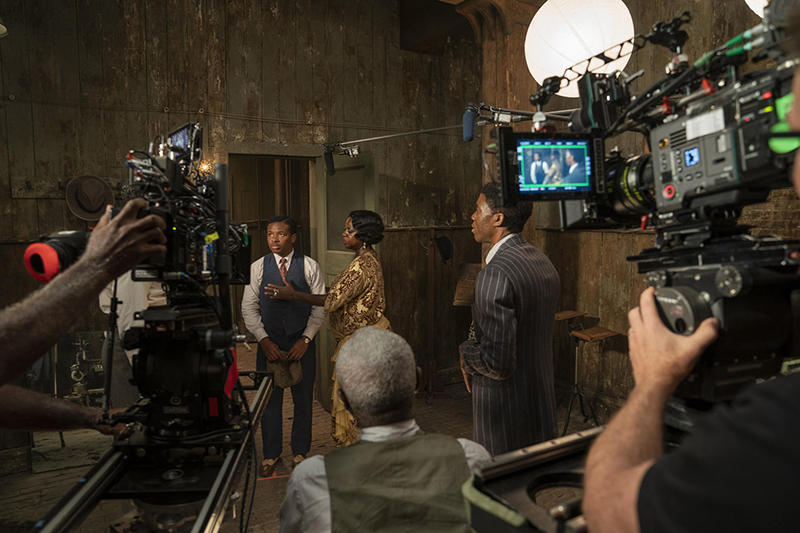
Dusan Brown, Viola Davis and Chadwick Boseman. Photo by David Lee/NETFLIX
Working in Close Quarters
The script describes the rehearsal room, where much of the story takes place, as a windowless basement storage room — no air, no light. Wolfe used the metaphor of “the underbelly of a slave ship,” from which the players could not escape, as an overall direction to his cast and crew. Added to that, Wolfe wanted the overbearing heat of Chicago in July to be represented.
“I thought, ‘Wow, how am I going to make this work?’” Schliessler recalls. The answer, he adds, came from a serendipitous moment at a scouted location by Ricker to reference texture and color on which the set would be based. One room had a tiny window perched high above floor level. Streaming through it, the sun struck Ricker perfectly where he stood, and Schliessler took a photograph immediately. The aura led both men to feel like they were “viewing a Caravaggio painting,” recalls Schliessler.
A two-foot-by-three-foot window was added to the very small set, which measured just 18 by 22 feet. For the most part, tungsten lighting was used on the set. A 20K Fresnel blasting through the window created the image of the hot sun bouncing off the floor. Schliessler used a softbox with Arri Sky Panels for general ambient light which he could easily adjust the color temperature and intensity. “The window helped me immensely in recreating the heat of that sun,” he notes. “I could focus the light on the actors and let the walls fall off.”
For 13 days, the actors, along with the film crew operating the dolly grips, cameras, tracks, sliders and peripherals worked that tiny space. “At first I was concerned about the close quarters, and what was required of all of us,” says Schliessler. “But the actors were so incredible, their performances so strong that the conditions faded into nothing.”
Tools for the Process
Schliessler chose the Sony Venice, a large format camera that produces 6K resolution, for its sharp full frame and shallow depth of field. Zeiss Supreme Prime lenses, meanwhile, gave director Wolfe the width to get closer in with minimal distortion, and a Tiffen diffusion filter called Bronze Glimmerglass brought a bit of warmth and sparkle. “It blooms the highlights and really helped create the feeling of heat,” Schliessler says.
Before actual filming begins, look up tables (LUTs) for the cameras are created — one for the interior, one for the exterior. Each LUT holds a set of numbers referenced by the software or hardware the cinematographer is using in order to deliberately change the colors of an image. Schliessler’s longtime colorist, Stefan Sonnenfeld at Company 3, developed the virtual color timing file.
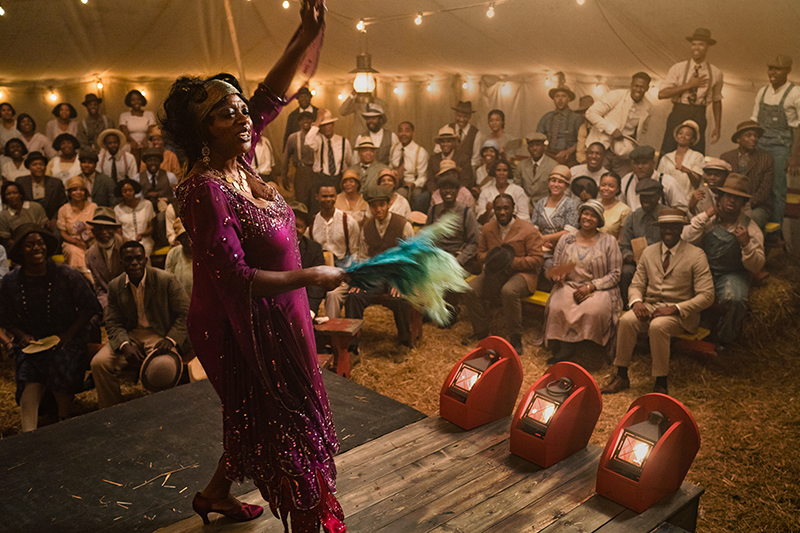
Lassoing the Natural World
“Shooting exteriors in a city always proves challenging,” notes Schliessler. Outside the recording studio was no exception. For continuity, the lighting crew had to make the rays creating or shading the sunlight mimic the CG background of Chicago. These scenes also served as the prime opportunity to portray the oppressive heat. Schliessler used 20×20 fly swatters covered with light diffusion and a total of six LRX 18K pars with 1/2 CTO on two Condor lifts.
Which brings us back to that opening scene. “I find one of the hardest things to do is create moonlight at night and make it look believable,” Schliessler says. “You have to be able to place the lights far enough away so you don’t heat up the trees in the foreground. We had an LED balloon for ambient light and two Arri M90 HMI pars on a Condor as the moon source. We also added a little smoke to silhouette our characters against the dark trees.
“Coming into this movie, I knew that it would be a challenge, given that most of the story takes place in one space and with limited options for lighting. That said, it’s these types of challenges that make my job exciting and continue to help me grow as a cinematographer. On one of my first calls with George, I voiced that I was a bit nervous about working in the small space and how would I light it, and he replied, ‘If you would know how to do it, why would you want to do it again?’ I loved this response, and it fueled me throughout the film. That said, making Ma Rainey was an amazing experience, and I am forever grateful to have collaborated with such a talented group of creatives.”
For more information on Tobias Schliessler, go to www.tobiasschliessler.com.
